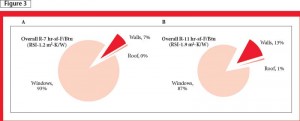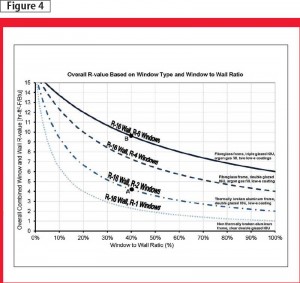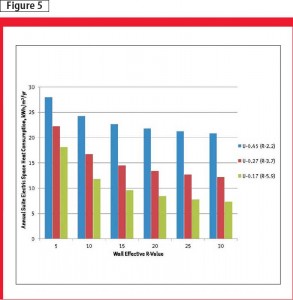Thermal importance of windows

High-rise, non-combustible buildings perform very differently from low-rise, wood-framed ones. High-rises also tend to have larger window-to-wall ratios (WWRs). The overall R-value calculations are repeated for a high-rise building with a greater proportion of windows:
- 35 per cent walls–R-16 (RSI-2.8);
- 5 per cent roof–R-40 (RSI-7.0); and
- 60 per cent windows–R-2 or U-0.5 (RSI-0.4 or USI-2.8).
The percentage of heat loss through each of the three enclosure components is shown in Figure 3. With a larger window area, heat loss through windows is now 93 per cent in the scenario with R-2 or U-0.5 (RSI-0.4 or USI-2.8) windows, with an overall enclosure R-3 (RSI-0.5). When the windows are upgraded to R-4 or U-0.25 (RSI-0.7 or USI-1.4), the overall R-value improves to R-6 (RSI-1.1)––an increase of R-3 (RSI-0.5) or 100 per cent. Even in this scenario, windows account for 87 per cent of heat loss even though they represent 60 per cent of the enclosure area.

Evaluating the impact of windows
Calculating approximate heat flows through the primary enclosure components can give designers a general idea of the relative importance of improving various enclosure components. Figure 4 shows the influence of window thermal performance and WWR on the overall building thermal performance.
For example, Point A represents a baseline window at 40 per cent WWR. At this point, even with an enclosure R-value of R-16 (RSI-2.8), the overall combined wall and window R-value is about R-4 (RSI-0.7). From this point, two fenestration changes can improve the overall R-value: decreasing the WWR or using better windows (i.e. lower U-value).
Improving the windows to insulated vinyl or fibreglass frames (Point B) increases the overall R-value to almost R-10 (RSI-1.8). Greater R-value improvements may be realized by decreasing the WWR.
Improving the windows versus improving the walls
In the design of a new building with a limited budget, designers may need to decide between improving window thermal performance versus improving the walls or roof. Similarly with energy retrofit projects, one can look at whether improving the walls, roof, or windows would have a greater effect on the overall enclosure R-value. The simple answer is to improve all assemblies as much as possible. In terms of where to spend money to get the most improvement, the answer is almost always the windows.

Figure 5 shows the effect of window U-value and wall R-value on annual space heating energy consumption for one suite in a typical Vancouver high-rise residential building. Improving the window U-value results in significant reductions to space heat energy consumption. However, given a particular window U-value, improving the wall R-value results in only small energy savings. This is because the windows account for a much greater proportion of heat loss through the enclosure. Improving the wall R-value has less impact on energy savings.
Selecting energy-efficient windows
Whether designing or selecting windows for a new construction or renovation project, it is important to consider the thermal performance of the windows to reduce building energy consumption. In general, windows with a low U-value will have a better thermal performance. Lower U-values can be achieved by selecting:
- double- or triple-glazed windows;
- one or more low-e coatings;
- argon gas fill;
- low-conductivity spacers; and
- low-conductivity frames (i.e. vinyl, wood, or fibreglass, as appropriate for the building type).
Selecting windows with an appropriate solar heat gain coefficient is also important. A higher SHGC can reduce heating requirements by increasing passive solar heat gains. However, a high SHGC also presents the risk of overheating the space and raising cooling energy. For non-shaded windows oriented south, east, and west, a low SHGC is typically preferred to prevent overheating or increased cooling energy. If the windows are shaded by exterior shades, adjacent buildings, trees, or other features, then a high SHGC may be used to provide more solar heat gain in the winter, but shade the windows in the summer. SHGC should be evaluated for each unique project.
Moderate WWRs typically result in better enclosure thermal performance and lower energy consumption. Window-to-wall ratios in the range of 20 to 40 per cent can provide winter heating, daylight, and views without excess heat loss. Greater WWRs typically result in significant heat loss due to poor enclosure thermal performance.
Conclusion
The thermal performance of windows contributes greatly to the overall energy consumption of a building. Although they may be a small portion of the overall building enclosure area, windows can account for a greater portion of heat loss through the enclosure.

In both new buildings and retrofits, it is important to address window thermal performance. One should choose windows with low U-values and select glazing with an SHGC appropriate for the specific project conditions. Investing in windows with a better thermal performance will pay back over time in energy savings, as well as help reduce energy consumption and greenhouse gas (GHG) emissions.
Brittany Hanam, MASc, EIT, is a building science engineer at RDH Building Engineering. She has more than three years of experience in the building science field. Hanam can be contacted via e-mail at bhanam@rdhbe.com.
Graham Finch, MASc, P.Eng., is a building science research engineer at RDH Building Engineering. He has more than seven years of experience in consulting engineering and building research. Finch can be reached at gfinch@rdhbe.com.
Dave Ricketts, MSc, P.Eng., is a principal and senior building science specialist at RDH Building Engineering. He has more than 30 years of experience in the building science field and is the chair of the Association of Professional Engineers and Geoscientists of B.C.’s (APEGBC’s) Building Enclosure Committee and past president of the BC Building Envelope Council (BCBEC). Ricketts can be contacted at drr@rdhbe.com.







